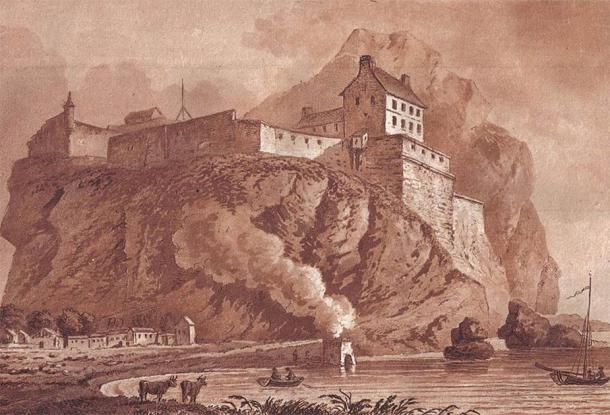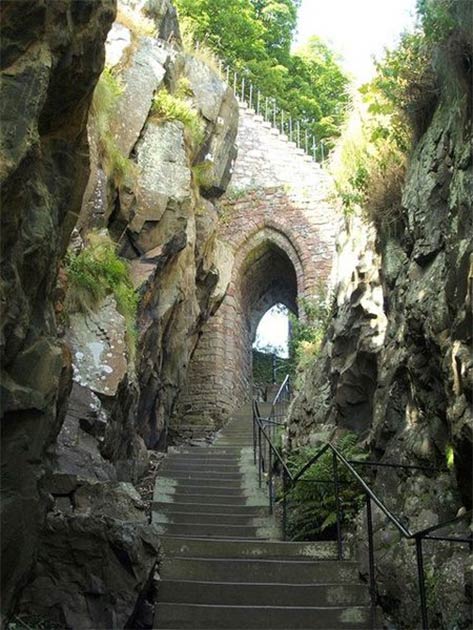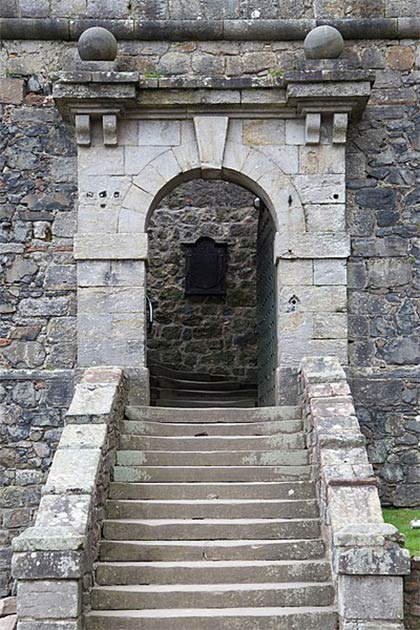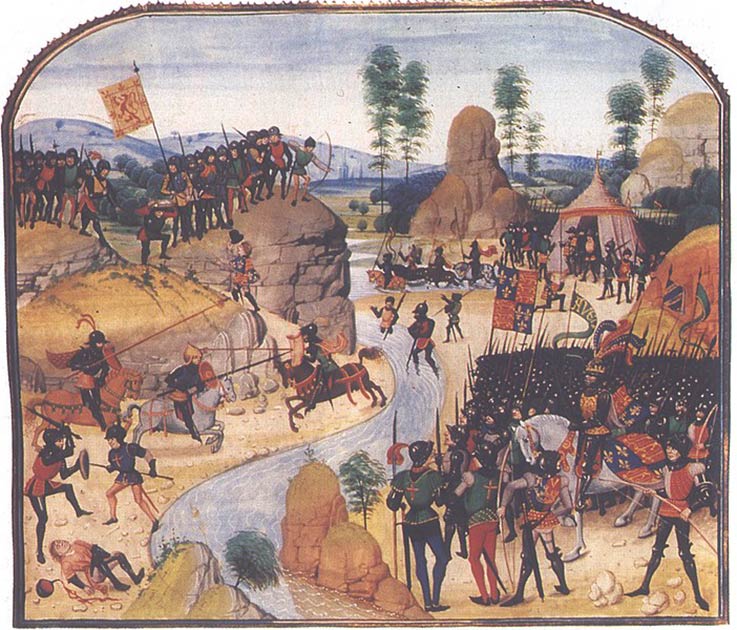
Dumbarton Castle: Ancient Stronghold and Symbol of Scottish Defiance
The wild and diverse landscapes of Scotland are filled with remnants of its rich and proud history that spans many centuries. From the Hebrides islands, to the border regions and all the way to the wild Scottish Highlands, the history of Scotland can be felt and seen everywhere. And amongst the major reminders of this history are the many castles, manor houses, and towers that dot the landscape, both ruined and preserved.
One of the oldest castles in Scotland, and certainly one of the most imposing and unique, Dumbarton Castle hides a rich history behind its stone walls, one that was crucial in the events that shaped the future of Scotland. Situated on a picturesque volcanic rock overlooking the River Clyde, Dumbarton Castle stands today as a mute witness of the events that reach far back into the earliest shaping of the modern Scottish nation.

Dumbarton Castle boasts the longest recorded history of any Scottish castle. (Public domain)
Pre-Iron Age Origins on Dumbarton Rock
Dumbarton Castle is special in many regards. Besides being perched at a strategically important location, this castle also boasts the longest recorded history of any Scottish castle. Located in West Dunbartonshire in Scotland, beside the eponymous town, the castle was established near where the River Clyde flows into the Firth of Clyde. Dumbarton town was always important in the region, being a center for shipbuilding, but also for glass making and the production of whisky.
The castle was built in a hard-to-reach location commanding impressive views overlooking the area. Perched at the base of an imposing plug of volcanic basalt, known locally as the Dumbarton Rock, the crag appeared an incredible 334 million years ago, according to geologic research, and is 73 meters (240 ft) tall.

The castle is perched at the base of an imposing plug of volcanic basalt which commands impressive views over the surrounding area. (Public domain)
The name Dumbarton comes from the Scottish Gaelic Dùn Breatainn, which means “Fort of the Britons”, offering clues into the actual origins of the site. While the earliest recorded mention of Dumbarton Castle dates back to the Iron Age, its history as a settlement reaches back even further. Back then, the area was a Brythonic kingdom called Alclud, roughly translating to Clyde Rock. With the gradual arrival of the Romans and the emergence of so-called Roman Britain, Alclud became an increasingly important and strategic site. Known as Caledonia, is reported to have been inhabited by the Picts before the Romans arrived. But whether it was the Brythons or the Picts dwelling there is anybody’s guess. Either way, in early Roman texts, several distinct tribes of the region are reported, with the fierce Atticotti inhabiting the region of Alclud (also known as Alt Clut), nowadays Dumbarton Rock or Dumbartonshire in general.
The town of Dumbarton most likely originated with the Romans. While the surrounding area was inhabited by Picts and Bryhons, the extent of Roman habitation reached about as far as the northern bank of the Clyde. Between the Clyde and the Forth, the Romans erected an extensive protective wall, inviting the inception of the town of Alcluith. The name most often connected with its creation is that of the Roman General Theodosius, who warred extensively with the restless tribes to the north of the Clyde.
It appears that Alcluith was founded around 368 AD, when General Theodosius, under the orders of Emperor Valentinian, led several campaigns against the Picts and the Scots to the north, and managed to seize a sizeable chunk of their lands. This then became another district within Roman Britain, known as Valentia. The northern borders of this district, stretching between the Clyde and the Firth, were subsequently strongly reinforced, and the town of Alcluith (most likely known as Theodosia by the Romans) emerged as a crucial frontier town.

19th century painting showing Dumbarton Castle on the left. The castle attracted tourists and travelers visiting for day trips during the 1800s. (Public domain)
At the Mercy of Foreign Invaders – the Rock Subdued
The Britons and the Picts were restless, and never fully submitted to Roman rule. Once the Roman era in Britain came to an end, around 400 AD, Alcluith once again fell into Brittonic hands. Beforehand this location was the seat of a long line of kings of the Strathclyde Britons. These successive generations of Britons always called the location “Dunbritton”, meaning “the Fort of the Britons”.
In about 756 AD, the castle once again became the backdrop for heated action when the King Eadgbert of Northumberland, accompanied by the King Uengust of the Picts, laid siege to Dumbarton Castle, conquered it, and lost it again several days later. The castle once again appears in the historic archives in 782 AD, when it was burnt and pillaged on the 1 st of January, though the accounts don’t mention by whom.
The following decades saw the re-establishment of the Alcluith settlement, and it continued to be the center of the Alclud kingdom. But in 872, a new dark page in its history was written. In that year, a force of Danish and Norwegian Vikings, based in Ireland, laid siege to the castle led by their petty Viking kings Ivar Beinlaus the Crippled (Ímar) and Óláfr the White (Amlaíb). The siege lasted for four months. When the castle’s water supplies finally ran out, the castle fell into Viking hands. The Vikings completely sacked and destroyed it, taking with them a host of captives. After this sacking, Dumbarton Castle isn’t mentioned in the archives again until the 13 th century.


Most of the structures that stand today were added later while the original Iron Age defenses have barely survived. The 14 th century Portcullis Arch (on the left) is the oldest surviving structure on Dumbarton Rock. (Left: Lairich Rig / CC BY-2.0 Right: Tom Parnell / CC BY-SA 4.0)
The Dumbarton Castle we can see today is almost completely of medieval construction. The original, Iron Age defenses have been archaeologically excavated and documented. The medieval fortifications were simply built, or upgraded, on top of the original fortifications. Furthermore, some of the earliest medieval elements of the castle complex have been destroyed through the ages. The oldest surviving segments are the Portcullis Arch and the guard house. Most other buildings, like the artillery defense emplacements, the governor’s house, prison, and powder magazines, were added later and can be traced to around the 17 th century. Dumbarton Rock, at whose base the castle stands, has two noticeable peaks. These are known as the Beak and the White Tower Crag.
Dumbarton Castle and the Wars of Scottish Independence
Around 1222, the strategic importance of Dumbarton Castle once again came into play. After its sacking by the Vikings a few centuries before, its strength certainly diminished. Stone crosses dating to the 10 th century were discovered in the vicinity, which signify some basic activity took place, perhaps of the religious variety. But around 1222, Alexander II, King of Scots, wanted to wrest back to his rule the areas of Scotland that were lost to the Norwegians. Dumbarton Rock’s strategic setting quickly became paramount, and Alexander erected a new castle at Dumbarton, proclaimed a royal castle in 1238.

During the Wars of Scottish Independence, Dumbarton Castle once again bore witness to the struggles for power over Scotland. (Public domain)
During the famous Wars of Scottish Independence, Dumbarton Castle once again saw considerable action. Edward I, King of England, captured the castle in 1296 and placed one of his chief knights in charge: Sir Alexander of Leeds. But in the unfolding events, and the victory of William Wallace over the English at Stirling Bridge at 1297, the castle once more returned to the hands of the Scots. At that time, the dungeons of the castle became the prison of three prominent English knights: Marmaduke Tweng, William Fitzwarrin, and William de Ros. They are the first historically documented prisoners of Dumbarton Castle.
The Scots suffered a heavy defeat in July of 1333, at the Battle of Halidon Hill. This was a dire time for Scotland, with only five castles actively holding out against the English forces. These were Urquhart, Lochleven, Loch Doon, Kildrummy, and Dumbarton Castle. After the defeat, the young king of Scotland, David II, was sheltered with his wife at Dumbarton Castle, from where he safely journeyed to France in the following year. David II spent a good number of years in captivity in England, but was eventually ransomed and managed to return to Scotland around 1357. It was then that he set about to rebuild and reinforce his castles, Dumbarton included. Several remnants of castle elements that date to this period can be seen today, although they did not stand the test of time.

Dumbarton Castle has been the site of several struggles over the ages, due to its strategic location on the River Clyde. (Eddie Mackinnon / CC BY-2.0)
The next centuries only saw more sieges and turmoil in which Dumbarton Castle was embroiled. Around the 1490s, the castle was in the hands of John Stewart, Earl of Lennox. He and his supporters sought the support of the English King Henry VII. Having previously supported the Scottish King James III, they earned the hostility of then current King of Scotland, James IV, who then twice laid siege against the Earl of Lennox at Dumbarton. After a hard siege, James managed to capture the castle, but only after help of naval bombardment. Once in his hands, the castle and the Dumbarton town become increasingly vital for their roles for shipbuilding and commerce. From here, James IV launched numerous expeditions and campaigns, making Dumbarton Castle his base. This continued during the reign of James V as well.

The Battle of Culloden, the final battle of the Jacobite Risings, when Charles Edward Stuart attempted to regain the British throne for his father. (Public domain)
The Final Battles of an Aging Fortress
The 1720s saw continued pressure rising in the Highlands, with the renowned Jacobite Risings in 1715 and 1719, which once again saw Dumbarton Castle in the spotlight. Believing the site to be important for defensive purposes, numerous repairs and upgrades are carried out by the English. George II ordered the reinforcing of the castle and upgrading of the northern defensive circuit, followed by a major upgrade to the south and west defenses. In the 1730s the three major cannon batteries receive a critical upgrade as well. It was at this time that the Governor House was built within the complex – more precisely in 1735.
The Jacobite Risings culminated tragically at the Battle of Culloden, which ended disastrously for the Scots. The damp darkness of the dungeons of Dumbarton Castle once more became the home of notable prisoners. This time they included the defeated Scottish Jacobite leaders, including the notable James Campbell of Auchinbreck and Aeneas MacDonald.
- Ruins of a Legendary Medieval Castle Uncovered in Scotland
- The Fascinating History of Medieval Castles: From Emergence to Obsoletion
- Eilean Donan Castle: From Jacobite Risings to the Silver Screen
From the mid 1800s onwards, Dumbarton Castle lost its importance and gradually became a tourist attraction. In 1843 its last Governor, Lord Lynedoch, died at age of 95. The failure to replace him further sealed the fate of the castle. After this it was governed on a volunteer basis, and received visits from numerous prominent individuals of the time.
However, conflict once again pushed Dumbarton Castle back into action, when in 1941 the slumbering relic awoke from its sleep to stand in defense of Scotland and the British Isles, due to its use as an anti-aircraft batter station. Between the 5 th and 6 th of May 1941, four high explosive bombs were dropped onto Dumbarton Rock by enemy fighters, the first attack it had suffered in over 300 years. Once again, the castle showed its defensive prowess, withstanding the attack as it had so many times before.

Between the 5 th and 6 th of May 1941, four high explosive bombs were dropped onto Dumbarton Rock by enemy fighters, the first attack it had suffered in over 300 years. (Ketelhohn / CC-BY-SA 3.0)
The Immortal Rock of the Clyde: Dumbarton Castle as Metaphor for the Scottish Nation
Whether under siege, assaulted with stones, swords, axes, cannon fire or muskets, pummeled by marching armies of English or Scottish warriors, or bombed by fighter jets, the Rock of the Clyde stood its ground. Ancient, fierce, and indomitable, the little castle hugged by 334 million-year-old volcanic basalt rock was destined to survive. And with that being said, we can clearly see an important metaphor emerging: that of the struggling fate of the Scottish nation, fighting off invaders and standing its ground no matter what. Just like old Dumbarton Castle.
Top image: Dumbarton Castle, overlooking the River Clyde Source: Richard Johnson / Adobe Stock.
By Aleksa Vučković















